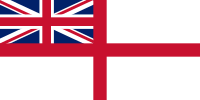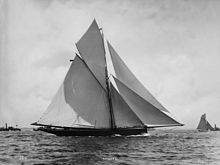Royal Yacht Squadron
 Burgee | |
 Ensign | |
| Short name | RYS |
|---|---|
| Founded | June 1, 1815 |
| Location | Cowes Castle, Isle of Wight |
| Commodore | Christopher Sharples |
| Website | www |
The Royal Yacht Squadron is one of the most prestigious yacht clubs in the world. Its clubhouse is Cowes Castle on the Isle of Wight in the United Kingdom. Member yachts are given the Suffix RYS to their names, and permitted to fly the White Ensign of the Royal Navy[1] rather than the merchant Red Ensign flown by the majority of other UK registered vessels. The club's patron is Queen Elizabeth II and the club's admiral is Prince Philip who is also a former club commodore.
History
Founded on 1 June 1815 in the Thatched House Tavern in St James's, London as The Yacht Club by 42 gentlemen interested in sea yachting,[2] the original members decided to meet in London and in Cowes twice a year, to discuss yachting over dinner. Membership was restricted to those who owned a vessel not under 10 tons. Today this is interpreted as a gentleman "actively interested in yachting".[1]
The Earl of Yarborough, later first commodore of the club, welcomed the Prince Regent as a member in 1817. In 1820, when the Prince Regent became George IV, it was renamed the Royal Yacht Club.
The club started organising racing as a principal feature of the annual regatta, which is now known as Cowes Week. In 1833, William IV renamed the club, The Royal Yacht Squadron. Its association with the Royal Navy began early and Nelson's captain at Trafalgar, Admiral Sir Thomas Hardy, headed the list of naval members. The spirit of invention led to yachts "of such celerity in sailing and beauty of construction" that they were of utility to the Royal Navy. In 1829, the Admiralty issued a warrant to wear what is now the navy's White Ensign. The burgee (a triangular shaped flag identifying yacht club membership) is differenced with a St George's Cross and crown on a white background.
In 1851, one of the "forred" hands, on board the yacht America concerning the first sailing of the America's Cup, 1851 wrote 'The Royal Yacht Club—In a fix' (tune). "Come listen to my ditty, and a song to you I'll sing..."[3]
Another naval connection is that the Antarctic explorer Robert Falcon Scott was a member of the Royal Yacht Squadron. To enable the application of naval discipline on board a civilian ship, he registered the Terra Nova RYS as a yacht of the squadron and sailed under the White Ensign on his second and final expedition to Antarctica in 1910.
Recently, Royal Yacht Squadron allowed full membership to women, which had been restricted since its foundation.
Racing

In 1851, the club's commodore, visiting the Great Exhibition, issued a challenge for the squadron's £100 Cup for a race around the island. The New York City–based America, representing the New York Yacht Club, triumphed in this race, giving its name to one of the oldest and best-known trophies: the America's Cup. The victory was witnessed by Queen Victoria and the Prince of Wales, later commodore of the club and Edward VII.
The site is also used as the start of the Round the Island Race which occurs annually.
During the American Civil War Deerhound RYS witnessed the fight between USS Kearsarge and the Confederate cruiser CSS Alabama. Gazelle RYS rescued the Empress Eugenie at the end of the Franco-Prussian War and the squadron yachts supplied British soldiers in the Crimean War.
The German Kaiser brought the 1887 America's Cup challenger Thistle, to Cowes in 1892 which encouraged the Prince of Wales to build Britannia, one of the most successful racing yachts of all time.
The Pavilion

The Pavilion, designed by Sir Thomas Croft, was opened in 2000. This elegant creation provides on shore facilities for yachtsmen and their families while allowing the castle to retain its 'country house' ambiance. The Pavilion also enabled the squadron to cross burgees with the New York Yacht Club in celebration of the 150th anniversary of the schooner America’s famous victory of 1851.
See also
References
Further reading
- Dear, Ian (1985). The Royal Yacht Squadron, 1815–1985. Stanley Paul.
- Guest, Montague; Boulton, William B. (1902). The Royal Yacht Squadron [...] Complete list of members with theirs yachts from the foundation of the club. John Murray.
- Pritchett, Robert Taylor (1894). "The Royal Yacht Squadron and The History of the Royal Cups". Yachting Volume II. Longmans, Green & Co, London. pp. 9–20.
- Reid, Julian (2015). Original Members of The Yacht Club.
